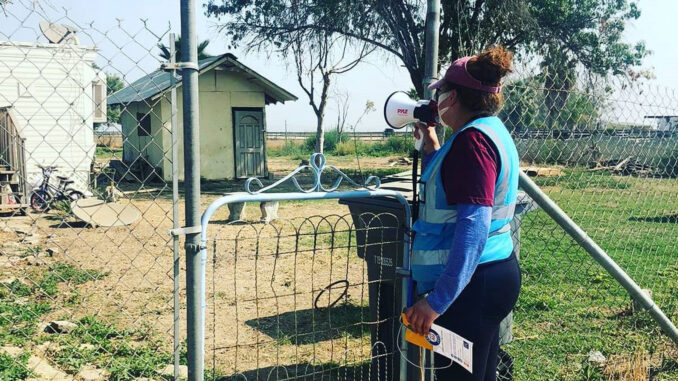
BY ALLEN PIERLEONI
College students are finding new ways to connect with neighbors in hard-to-count communities
Making personal contact with neighbors in hard-to-count communities is the most grass-roots form of Census outreach, and likely the most exacting.
Knocking on those doors presents unique challenges for enumerators, yet Reyes Uviedo and his team have devised creative strategies as they make their way through Census tracts in the San Joaquin Valley.
Uviedo is the manager of the nonprofit Central Valley Partnership and director of its Census Outreach Program. He supervises a team of 24 college students working part time.
“We make sure our students understand what the Census is and its importance, so when they go to a door, they carry conviction and persistence in their narrative,” Uviedo says.
Uviedo and his team recently spent time in the neighboring Tulare County towns of Traver and London, where there are no sidewalks but a lot of dogs, with closed-off houses set behind fences and big gates, he says.
“It’s really difficult to get to those people because of the physical barriers,” Uviedo says. “Most of my students carry bullhorns and stand outside the gates [encouraging people to] ‘Come out!’” and talk about the Census.
Once at the front door, the students create trust by explaining that they’re with a nonprofit community organization and not the federal government, Uviedo says. “We tell them, ‘We are not the Census; we’re [from a community-based organization and] here to help you complete the Census form.’”
Another tool is explaining to residents that for every person counted in a community, that community will receive $20,000 worth of resources over the next 10 years. This argument often is successful.
“When we go to neighbors who are [hesitant], we tell them, ‘Do the Census or your neighboring town will take the funding from your town.’ Money is a big convincer.”
In spite of the challenges, Uviedo remains optimistic. “COVID hit these communities hard and we’re fighting against the odds, but we’re making strides,” he says. “Without nonprofits like ours at the doors, we could be in a lot worse situation.”

